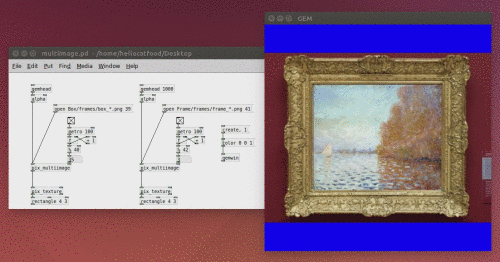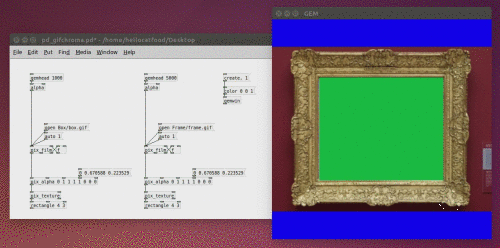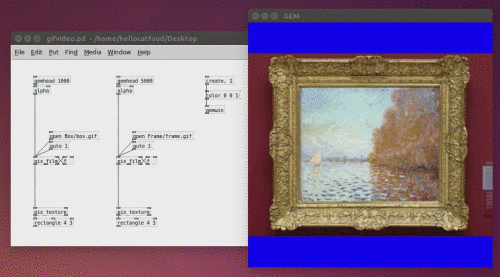Every so often on my travels across the information superhighway I come across a Pure Data user asking if animated gif files can be read in Pure Data. Technically speaking they have always been able to be read in Pure Data, but not always in a way that a user usually wants. Using the [pix_image] object a user can read almost any image file format. On Linux this is dependent on ImageMagick, so whatever it can read can (theorectically) be displayed in Pure Data/GEM. The problem arises because [pix_image] doesn’t display animated gifs as animations, only the first frame.
There are several solutions to this problem. For these examples I’m going to use the following two gifs:
Click through each image to get the full-sized original versions.
[pix_multiimage]
If you separate the gif into its individual frames you can use [pix_multiimage] to display each frame in succession.

Click to download the PD patch.
Benefits
The benefits of using [pix_multiimage] to simulate an animated gif are that you can display high quality images with an alpha channel at whatever frame rate you choose. Simulating stutter effects or reversing is as easy as using a [counter] or random number generator.
Drawbacks
The problems with this approach are that [pix_multiimage] needs to be told how many frames to cycle through, and not all gif animations have the same amount of frames. [pix_image] and even [pix_data] do not report information about the amount of frames in an animation, so that value cannot be passed to [pix_multiimage]. Assuming that you separate your gifs to their individual frames, an abstraction can be built that can detect how many images there are in a directory and then send that value to [pix_multiimage] but that is a lot of effort to go through!
Convert gif to video
The technique that perhaps most PD users have used is to convert the gif into a video file and use [pix_film] to play it. I used the following script to convert a folder full of gifs into mp4 files, with all transparent pixels converted to green pixels:
With the gif now converted to a video you can use [pix_film] to play a video as you normally would.

Click to download the PD patch.
Benefits
So far I have only tested playing animated gifs in Pure Data using Gmerlin on Ubuntu. Without knowing if the same would work on Windows or Mac OSX, using video files is the safest option for all users.
Drawbacks
Any sort of file conversion will reduce the quality of the output, and this method is no exception. The videos aren’t very sharp, especially at the borders of the green pixels.
Making the green pixels transparent using [pix_chromakey] or [pix_alpha] requires fine-tuning to ensure that other colours aren’t made transparent. This isn’t always 100% reliable and can have a few glitchy artifacts.
Using gifs directly with [pix_film]
Another approach is to use [pix_film]. “Hold on” I hear you say, “[pix_film] can only be used to play films! How dare you suggest that it can be used to play image file formats. Balderdash!”. Well, don’t beleive the hype! As a Linux user, I can only comment on this working on Linux. If anyone can get the following methods to work in any other OS please get in touch and I’ll add it here.
When you play media file formats in Pure Data on Linux you’re actually using external programs and libraries to play them. So, you’ll use ffmpeg/libav to play videos and Imagemagick to display images. There’s also another program you can use, Gmerlin. Install it by executing sudo apt-get install gmerlin. Pure Data/GEM has some weird behaviour whereby the delay amount of a gif needs to be explicitly set to a value 1 or above in order for an animated gif to be played. This can be achieved on a folder full of gifs by executing mogrify -delay 1 *.gif.
And now you can easily open an animated gif in Pure Data the same way you would a video file.

Click to download the PD patch.
Benefits
Gifs, unlike (most) video file formats can have an alpha channel. Another benefit is that you don’t need to deal with converting files. No longer will you have to worry about whether an mp4 is faster or more effecient than an mp4, or what codec to use. Gifs will just be gifs.
Drawbacks
If the original format of your source file is a gif, then perhaps it is more efficient to keep it as a gif. If it was a video file, would it be beneficial to convert it to a gif? Not always. Even if you could achieve a smaller file size or have PD use less processor power by using a gif, the quality of the video output would be reduced due to gifs only allowing 256 colours.
It’s pronounced “gifs”
There are perhaps other benefits and drawbacks to each approach that I haven’t written about or haven’t even thought about. One such example of both is processor usage of each method. I suspect using gifs is actually less efficient, but I don’t have a good method of testing this. Perhaps one of y’all could!


